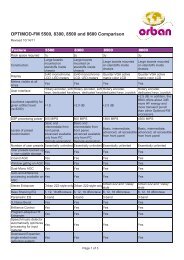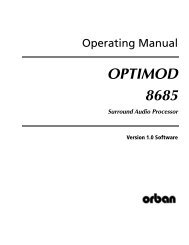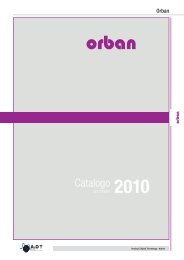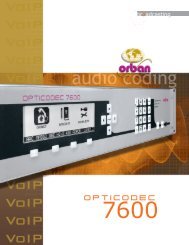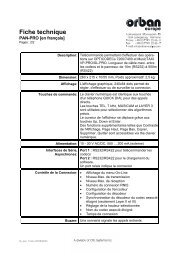one for three - Orban
one for three - Orban
one for three - Orban
Create successful ePaper yourself
Turn your PDF publications into a flip-book with our unique Google optimized e-Paper software.
specifications<br />
specification<br />
PERFORMANCE<br />
INSTALLATION INSTALLATION<br />
It is impossible to characterize the listening quality of even the simplest limiter or<br />
compressor based on specifications, because such specifications cannot adequately<br />
describe the crucial dynamic processes that occur under program conditions. There<strong>for</strong>e,<br />
the only way to evaluate the sound of an audio processor meaningfully is by subjective<br />
listening tests.<br />
Certain specifications are presented here to assure the engineer that they are<br />
reasonable, to help plan the installation, and make certain comparisons with other<br />
processing equipment.<br />
Specifications apply <strong>for</strong> measurements from analog left/right input to analog left/right output.<br />
Frequency Response<br />
(Bypass Mode)<br />
Noise<br />
Total System L/R Channel<br />
Separation<br />
Polarity<br />
Internal Processing Sample<br />
rate<br />
Processing Resolution<br />
Delay<br />
Operating Mode<br />
Depending on settings, is flat or follows standard 50 µs or 75 µs pre-emphasis curve<br />
±0.10 dB, 20 Hz – 20 kHz. (At 32 kHz input samplerate, the passband is reduced to<br />
approximately 14.7 kHz.) Analog left/right output and digital output can be user-configured<br />
<strong>for</strong> flat or pre-emphasized output.<br />
Output noise floor will depend upon how much gain the processor is set <strong>for</strong> (Limit<br />
Drive, AGC Drive, Two-Band Drive, and/or Multiband Drive), gating level, equalization,<br />
noise reduction, etc. The dynamic range of the A/D Converter, which has a specified<br />
overload-to–noise ratio of 110 dB, primarily governs it.<br />
The dynamic range of the digital signal processing is 144 dB.<br />
>70 dB, 20 Hz – 20 kHz; 90 dB typical (analog I/O).<br />
Digital I/O separation is essentially infinite.<br />
(Bypass Mode; Operate Mode when processing chain is configured <strong>for</strong> linear phase):<br />
Absolute polarity maintained.<br />
Positive-going signal on input will result in positive-going signal on output.<br />
48 kHz. We believe this provides maximum audible transparency by minimizing numerical<br />
“noise” in the equalizers and filters while still preserving a pure, transparent<br />
sound. The double-precision equalizers and crossover filters used throughout the 6300<br />
produce at least 6 dB lower noise and nonlinear distortion than they would at 96 kHz.<br />
Internal processing has 24 bit (fixed point) or higher resolution;<br />
uses Motorola DSP56367 chips.<br />
The minimum available input/output delay is approximately 20 ms, as determined by<br />
the advanced “look-ahead” processing algorithms employed.<br />
This can be padded to exactly <strong>one</strong> frame of 24, 25, 29.97 or 30 frames/second video<br />
up to a maximum delay of 50 ms.<br />
Stereo or dual-mono. In dual-mono mode, both processing channels have the same<br />
subjective adjustments (as determined by the active preset) but are otherwise independent,<br />
making this mode appropriate <strong>for</strong> dual-language transmissions.<br />
Operating mode can be set via GPI, Ethernet and serial connections, internal clockbased<br />
automation and AES3 Status Bits.<br />
Analog Audio Input<br />
Configuration Stereo / Dual-Mono.<br />
Impedance >10 kΩ load impedance, electronically balanced.<br />
Nominal Input Level Software adjustable from –4.0 to +13.0 dBu (VU).<br />
Maximum Input Level +27 dBu.<br />
Connectors<br />
Two XLR-type, female, EMI-suppressed. Pin 1 chassis ground, Pins 2 (+) and 3 electronically<br />
balanced, floating and symmetrical.<br />
A/D Conversion 24 bit 128x oversampled delta sigma converter with linear-phase anti-aliasing filter.<br />
Filtering<br />
Analog Audio Output<br />
RFI filtered, with high-pass filter at 0.15 Hz (–3 dB).<br />
Configuration Stereo. Flat or pre-emphasized (at 50 µs or 75 µs), software-selectable.<br />
Source Impedance 50 Ω, electronically balanced and floating.<br />
Load Impedance 600 Ω or greater, balanced or unbalanced. Termination not required or recommended.<br />
Output Level<br />
Adjustable from –6 dBu to +24 dBu peak, into 600 Ω or greater load,<br />
(100% peak modulation)<br />
software-adjustable.<br />
Signal-to-Noise<br />
≥100 dB unweighted<br />
(Bypass mode, 20 Hz – 20 kHz bandwidth, referenced to 100% modulation).<br />
Distortion ≤0.01% THD (Bypass mode, de-emphasized) 20 Hz – 20 kHz bandwidth.<br />
Connectors<br />
Two XLR-type, male, EMI-suppressed. Pin 1 chassis ground,<br />
Pins 2 (+) and 3 electronically balanced, floating and symmetrical.<br />
D/A Conversion 24 bit 128x oversampled.<br />
Filtering<br />
Digital Audio Input<br />
RFI filtered.<br />
Stereo or Two-Channel (dual-mono) per AES3 standard, 24 bit resolution, software<br />
Configuration<br />
selection of stereo or dual-mono. Unit can detect Stereo or Two-Channel status bits<br />
and switch modes appropriately.<br />
User Bits Unit can pass AES3 User Bits from its AES input to AES Output #1.<br />
Sample Rate 32, 44.1, 48, 88.2 or 96 kHz, automatically selected.<br />
Connector<br />
XLR-type, female, EMI-suppressed. Pin 1 chassis ground, pins 2 and 3 trans<strong>for</strong>mer balanced<br />
and floating, 110 Ω impedance.<br />
10




